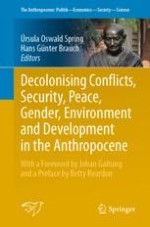In this book 25 authors from the Global South (19) and the Global North (6) address conflicts, security, peace, gender, environment and development. Four parts cover I) peace research epistemology; II) conflicts, families and vulnerable people; III) peacekeeping, peacebuilding and transitional justice; and IV) peace and education. Part I deals with peace ecology, transformative peace, peaceful societies, Gandhi’s non-violent policy and disobedient peace. Part II discusses urban climate change, climate rituals, conflicts in Kenya, the sexual abuse of girls, farmer-herder conflicts in Nigeria, wartime sexual violence facing refugees, the traditional conflict and peacemakingprocess of Kurdish tribes, Hindustani family shame, and communication with Roma. Part III analyses norms of peacekeeping, violent non-state actors in Brazil, the art of peace in Mexico, grass-roots post-conflict peacebuilding in Sulawesi, hydrodiplomacyin the Indus River Basin, the Rohingya refugee crisis, and transitional justice. Part IV assesses SDGs and peace in India, peace education in Nepal, and infrastructure-based development and peace in West Papua.
• Peer-reviewed texts prepared for the 27th Conference of the International Peace Research Association (IPRA) in 2018 in Ahmedabad in India.• Contributions from two pioneers of global peace research:a foreword by Johan Galtung from Norway and a preface by Betty Reardon from the United States.• Innovative case studies by peace researchers on decolonising conflicts, security, peace, gender, environment and development in the Anthropocene, the new epoch of earth and human history.• New theoretical perspectives by senior and junior scholars from Europe and Latin America on peace ecology, transformative peace, peaceful societies, and Gandhi’s non-violence policy.• Case studies on climate change, SDGs and peace in India; conflicts in Kenya, Nigeria, South Sudan, Turkey, Brazil and Mexico; Roma in Hungary;the refugee crisis in Bangladesh; peace action in Indonesia and India/Pakistan; and peace education in Nepal.
